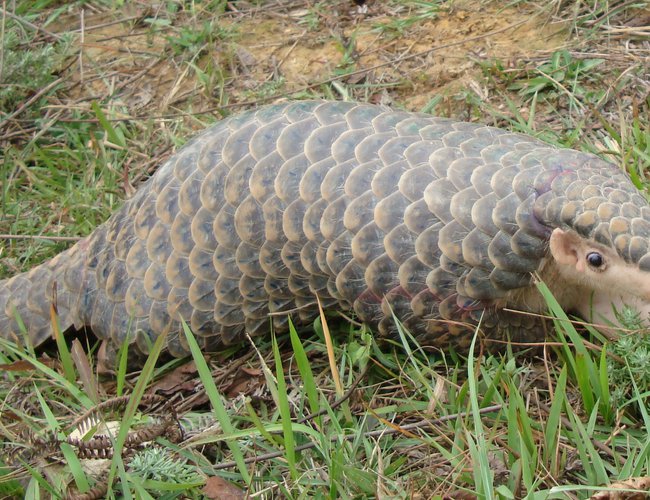
 How much amount of “Khapeto’’– protective scale
covering the skin of pangolin- “Salak’’ -do you need Sir? Nevertheless, would
you mind waiting for few days so that I can make you them available? These
questions were asked to me by a young local farmer few years back when I was in
Taplejung district of eastern Nepal for the study of illegal trade of
pangolins. He was totally unaware of the purpose of my visit and thought I was
someone looking for the business deal as I showed curiosity about the trading
of valuable “Khapeto”. This simple conversation shook me to the core as it
reflected how intensely the illegal trade of pangolin’s scale has proliferated
widely and deeply in the area. The informal conversation in the tea shop about
the incidents of poaching of pangolins for the scale was mundane activity of
daily life. Every alternate person, including very young to old people of that
particular village, we met shared about new stories of illegal trade. However,
contrarily, there was no evidence of seizing pangolin in the police record of
District Police Office.
How much amount of “Khapeto’’– protective scale
covering the skin of pangolin- “Salak’’ -do you need Sir? Nevertheless, would
you mind waiting for few days so that I can make you them available? These
questions were asked to me by a young local farmer few years back when I was in
Taplejung district of eastern Nepal for the study of illegal trade of
pangolins. He was totally unaware of the purpose of my visit and thought I was
someone looking for the business deal as I showed curiosity about the trading
of valuable “Khapeto”. This simple conversation shook me to the core as it
reflected how intensely the illegal trade of pangolin’s scale has proliferated
widely and deeply in the area. The informal conversation in the tea shop about
the incidents of poaching of pangolins for the scale was mundane activity of
daily life. Every alternate person, including very young to old people of that
particular village, we met shared about new stories of illegal trade. However,
contrarily, there was no evidence of seizing pangolin in the police record of
District Police Office.
These events and verbatim triggered me even after so many years and I shared it to my colleagues as we are celebrating the seventh annual World Pangolin Day on 17th February 2018. World Pangolin Day is celebrated on the third Saturday of February every year.
What are Pangolins?
Pangolins are solitary, primarily nocturnal animals, and referred as scaly anteaters as their body is covered by scales and they feed on insects, especially ants and termites. Besides the scales, they are equipped with powerful claws to dig burrows and long sticky tongues to collect insects. As a defense, if they encounter any threat they usually roll up their body and fully cover up their head and underneath parts. A pangolin can consume as much as 70 million insects per year—mainly ants and termites. Thus, they play important role in checking the population of insects in the ecosystem. This helps in checking the destruction caused by the ants and termites in our surroundings. Their burrow digging behavior helps in aerating soil to increase productivity of the land that helps to flourish vegetation in their natural habitat.
Initiatives for the conservation
Two species of pangolins are found in Nepal. They are Indian pangolin (Tame Salak) and Chinese pangolin (Kalo Salak). The Chinese pangolin is listed as Critically Endangered (CR) and Indian pangolin as Endangered (EN) in the IUCN Red List. Both the Chinese and Indian pangolin are protected by Government of Nepal under the National Park and Wildlife Conservation Act 1973 (2029 BS). National conservation status of both species has been assessed as Endangered. However, very few studies have been done on pangolins in Nepal which were limited to small areas. Recently in 2016, Small Mammals Conservation and Research Foundation (SMCRF) conducted a National Pangolin Survey and also drafted a monitoring protocol for pangolins with the support of Ministry of Forest and Soil Conservation (MOFSC). This is a positive initiation from Nepal for the global community working in research and conservation of pangolins. The study has confirmed 43 districts of Nepal with the presence of the pangolins. They are found mainly in the eastern and central region of the country, including the Chure range. Most of the areas with the presence of pangolins are outside of protected areas which receive less protection or none. Along with these, Pangolin Conservation Action Plan for Nepal (2016-2020) has also been drafted to ensure the long term sustainable actions for the conservation of both species of pangolins in Nepal.
Gaps in conservation efforts
Despite continuous effort from the government for the conservation of wildlife, the Central Investigation Bureau (CIB)-the national investigation agency of Nepal reports the increase in the illegal trade of pangolin scales by almost 800 percent just between 2009 and 2015. The question arises why this rate of illegal trade has been increasing at an alarming rate.
Less preferred species
One of the reasons behind increasing rate of poaching of pangolin is that the Government’s initiatives are very recent while the illegal trade has already been deep-rooted in our society. It can be said that government had never prioritized this species as other flagship species such as tiger, elephant and rhinoceros in the past although it was categorized as protected species. However, now the Government of Nepal has been continuously putting its effort to conserve this species through controlling its illegal trade but success is a far cry.
Negative media news coverage
National daily coverage on smuggling news about pangolins clearly mentioning about their price in illegal market may have created a negative message among local people. Such news about the high price of pangolins has been adversely affecting mind set of locals provoking them on adopting the smuggling of pangolins as the easy way of making money.
Unrevealed threats to pangolins in Nepal
Globally, poaching is another major threat to this
species. In addition to that, a study done by SMCRF found that some communities
like Aathrai, an ethnic community called as type of Rai, who mostly settle at
Dhankuta consider sighting of pangolins as misfortune. Similarly, in Taplejung,
some communities consider encountering with pangolins as a bad luck causing
death of family members. They believe that the only way to save the life of
family member from the curse of such death is to kill this innocent creature.
(Caption: Killed Indian Pangolin due to a fatal road accident as found in District Forest Office, Dhankuta. Photo Courtesy: Kaustuv Raj Neupane)
Awareness building is the must
In order to control the illegal trade of the species community level awareness raising programs should be done along with other conservation efforts. Usually, awareness program are taken as simple and supplementary events only but if we are to conserve pangolins the programs of building awareness in the community where pangolin is considered as “threats” and “bad luck” should be prioritized as the prime solution.
Need of conservation efforts beyond protected areas
Finally, the government standalone cannot conserve these threatened small mammals- the pangolins. For this, local people should equally unite against the poaching of pangolins and initiate the conservation efforts such as increasing awareness at local level. Not only protected areas but also the forest managed by community should be made equally responsible for the conservation of these species. Media should cover more news on ecological importance of the species rather than just indicating high demand of these species in black market. Nepal has already proved that community based anti-poaching operations within the protected areas is successful conservation initiatives with the coordinated effort of local people and government. In addition, Nepal has also been a very proud nation to share its news on zero poaching years for large mammals such as rhinos, tigers and elephants.
Therefore to conserve these small yet important endangered mammals government
should keep it in its priority list.
Based on the recent studies it has been found that the habitat of pangolins is mainly beyond the protected areas mostly in community managed forests. However, the management plan of Community Forest User Group (CFUG) has never focused on conservation of wildlife nor do they have sufficient manpower to tackle with poachers. Nepal’s community forest approach is considered as one of the successful models of conservation that focuses on conservation of trees and Non Timber Forests Products (NTFP). Now it the high time to rethink the objective of each CFUG based on the need and resources it has. These CFUGs can add provision of conserving wild animals with special focus on small creatures like pangolins. Special programs of sustainable livelihood promotions, strict punishments and fines for poaching and need for active participation of community in conserving the ecologically important wildlife through necessary amendments in the CFUGs management plan can play vital role in abating the problem of pangolin poaching and illegal trade.















